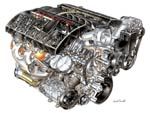
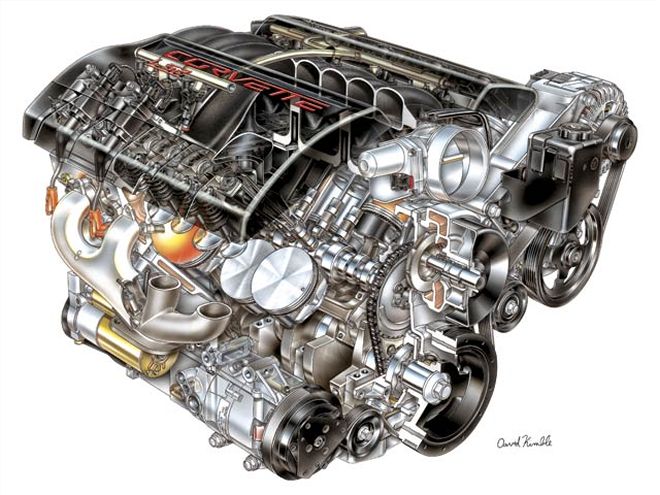
It's fitting that during the 50th anniversary year of the small-block Chevy, arguably its two greatest variations have been released. First, the 400hp 6.0L LS2 arrived for the '05 model year in the latest-generation Corvette, followed recently by the news of the giant-killer small-block: the 500hp 7.0L LS7 that will arrive this fall in the '06 Corvette Z06.
Looking back, the small-block engine design that debuted with 265 ci and 195 hp doesn't seem like much of a world beater, but in its day, it was a world-class engine with lightweight head and block castings and an overhead valvetrain that was ahead of its time. Today, we look at the latest LS6/LS7 engines and see race-inspired technology, including lightweight valves, cross-bolted main caps, and rollerized rocker arms. Back in 1955, Chevy's new small-block was just as revolutionary, and in those days, it too was regarded as being heavily influenced by racing technology, so its staggering racing success was pretty much a foregone conclusion.
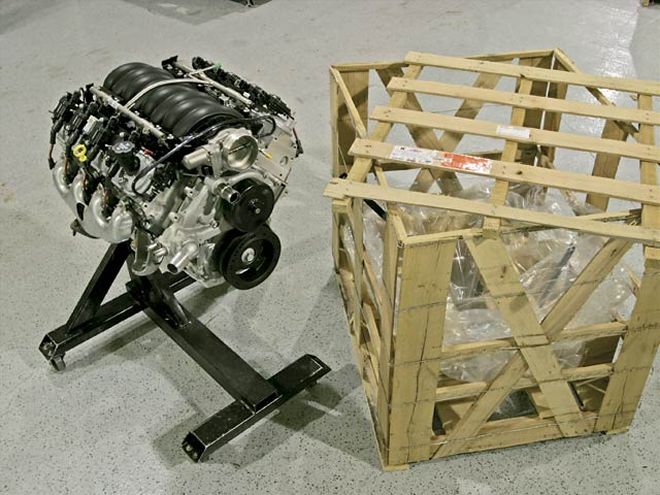 Out-of-the-box performance from GMPP means you can have a factory-direct LS2 shipped to your door for about $6,400. It comes with a standalone wiring harness and controller, but bolting it into anything that didn't originally come with at least a Gen III small-block is up to you to figure out.
Out-of-the-box performance from GMPP means you can have a factory-direct LS2 shipped to your door for about $6,400. It comes with a standalone wiring harness and controller, but bolting it into anything that didn't originally come with at least a Gen III small-block is up to you to figure out.
GM actually refers to the current LS2 and LS7 as fourth-generation revisions of the classic design, although the only direct commonality all four generations share is the 4.400-inch center-to-center bore spacing. Since so many critical dimensions have changed over the years to the point that there are no interchangeable parts, it may be stretching the definition a bit to call these latest incarnations direct descendants of the engines that debuted in the '55 Chevy, but the fact that GM's bread-and-butter small-block V-8s still feature a cam-in-block design with pushrod-activated valves is enough for us to issue a pass on the subject.
We asked Dan Nicholson, GM's chief engineer in charge of small-block and big-block engines, why the company has stuck with pushrods for all these years when so many other manufacturers have gone to overhead-cam designs.
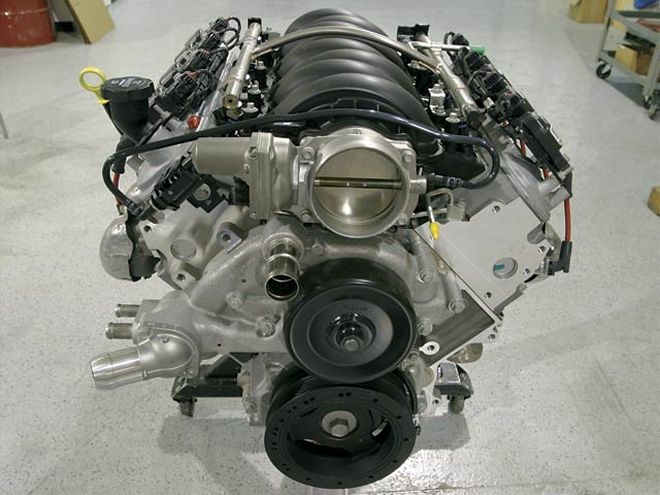 Compactness, simplicity, and durability are three hallmarks the latest Gen-IV small-block shares with its ancestors.
Compactness, simplicity, and durability are three hallmarks the latest Gen-IV small-block shares with its ancestors.
"The pushrod [design] has the inherent advantage of compactness and a reduced number of components, and that will continue to be an advantage as long as we can continue to keep the cost, weight, and friction down and the valvetrain speed up to produce the power we need. That's what will continue to keep it in the ballgame," Nicholson told us, noting that typical customers are more concerned with the practical power and performance an engine delivers rather than the location of its cams or method of valve actuation.
"I think General Motors right now has a lot more credibility with regard to our overhead-valve pushrod engines being viable because we have the whole portfolio covered. Frankly, we were saying a lot of the same things in the '80s and '90s, but there was a skepticism because it was a little more like, 'Well, you're just trying to sell the stuff you have,' before we had outstanding overhead-cam engines like the Northstar, our new high-feature V-6, and our Ecotec four-cylinder engine," Nicholson says.
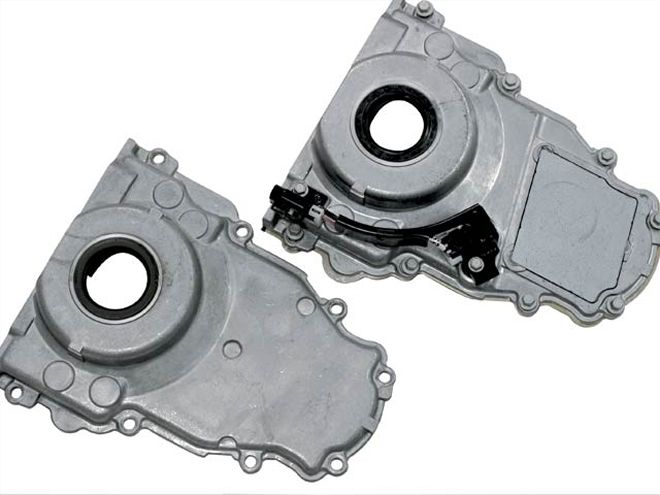 The Gen-IV timing cover (right) has been revised by moving the camshaft position sensor to the front of the block. A damping plate has also been added to reduce NVH coming from the chain.
The Gen-IV timing cover (right) has been revised by moving the camshaft position sensor to the front of the block. A damping plate has also been added to reduce NVH coming from the chain.
"Now we've got all those engines, and yet this [LS2] is still a viable product. When we came out with the Gen III in the late '90s about the same time Ford came out with its modular V-8, some people thought, 'How can you compete with the Gen III?' The Ford guys thought we were nuts. Now here we are seven or eight years later and the marketplace has spoken, I think clearly, on that." Considering that no stock modular Ford V-8 has yet produced 400 hp without a blower, we can't disagree.
The LS2 is available now in the C6 Corvette, SSR roadster pickup, and '05 Pontiac GTO, and GM Performance Parts is already shipping LS2 crate engines to customers straight from the assembly line, so this new small-block should develop quite a following among enthusiasts right off the bat.
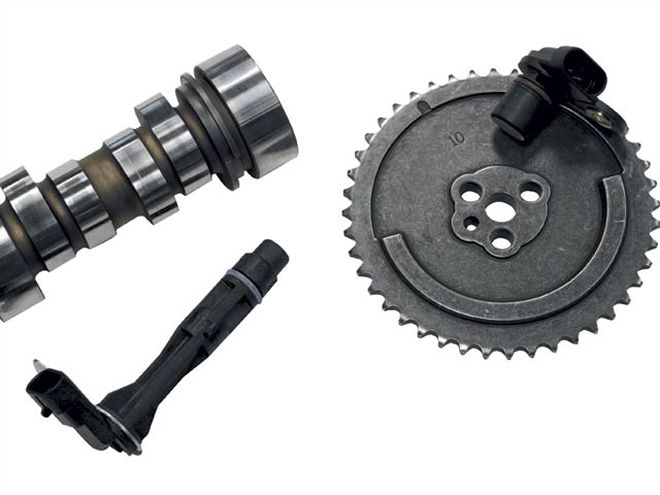 A major change in the Gen-IV architecture is the relocation of the camshaft sensor from the back of the engine to the front. To accommodate this change, the camshaft sprocket (right) has been redesigned with a raised rib that generates a signal once per camshaft rotation. On Gen-III engines, the camshaft-sensor pickup is located at the back of the block and reads its signal directly off the camshaft (left). The change simplifies OE camshaft machining but probably won't affect aftermarket grinders, who will likely continue to use Gen-III-style cam cores for both applications.
A major change in the Gen-IV architecture is the relocation of the camshaft sensor from the back of the engine to the front. To accommodate this change, the camshaft sprocket (right) has been redesigned with a raised rib that generates a signal once per camshaft rotation. On Gen-III engines, the camshaft-sensor pickup is located at the back of the block and reads its signal directly off the camshaft (left). The change simplifies OE camshaft machining but probably won't affect aftermarket grinders, who will likely continue to use Gen-III-style cam cores for both applications.
To see just how much the Gen IV design differs from its immediate predecessor, we asked for help from General Motors performance-engine guru Mark McPhail, who recently left GM to head up Katech's new street performance division. Anyone familiar with the racing career of the small-block Chevy in recent years is surely familiar with Katech's Le Mans-winning engines that powered the C5-R Corvette to multiple class wins in the annual 24-hour endurance race. Katech has been joined at the hip with GM Racing during its 20-plus-year history and has recorded race wins in Trans-Am, IRL, IMSA, and the NASCAR Busch series among others. McPhail and his colleagues at Katech are pretty far ahead of the curve in Gen III/IV development, having worked hand-in-hand with engineers at GM on numerous racing and R&D endeavors during development of the platform, and they had all the parts on hand, including a just-arrived GMPP LS2 crate engine.
In this first of a two-part series, we'll dissect the major physical differences between the Gen III and Gen IV. In the second part, we'll strap that crate engine onto Katech's dyno and test several combinations of cams, heads, intakes, and exhaust manifolds to see just how well the new design responds to good, old-fashioned hot rodding.